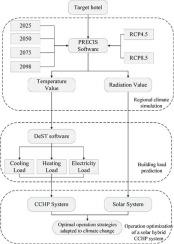当前位置:
X-MOL 学术
›
Energy Convers. Manag.
›
论文详情
Our official English website, www.x-mol.net, welcomes your
feedback! (Note: you will need to create a separate account there.)
Operation optimization of a solar hybrid CCHP system for adaptation to climate change
Energy Conversion and Management ( IF 9.9 ) Pub Date : 2020-09-01 , DOI: 10.1016/j.enconman.2020.113010 Xu Wang , Ye Xu , Zhe Bao , Wei Li , Feng Liu , Yuntian Jiang
Energy Conversion and Management ( IF 9.9 ) Pub Date : 2020-09-01 , DOI: 10.1016/j.enconman.2020.113010 Xu Wang , Ye Xu , Zhe Bao , Wei Li , Feng Liu , Yuntian Jiang

|
Abstract Combined cooling, heating, and power system (CCHP), coupled with solar energy, have been widely used in building energy supplies. This is because they have the advantages of high energy utilization efficiency and lower pollution emissions. However, there are many influencing factors, complicated structures, and fluctuations in renewable energy sources, which led to ineffective system scheme configurations. In particular, the fluctuations in meteorological elements, such as temperature and radiation under climate change, have increased the difficulty of forecasting user’s load and estimating renewable energy output. This research used a five-star hotel in Shanghai, China, as a study case and established an improved version of operation optimization model of a solar hybrid CCHP system. There are two major innovations: (i) Regional climate simulation software PRECIS was applied to predict the temperature and radiation changes in this region over the next 80 years, and the predicted results were plugged as the inputs to the DeST software and solar system output calculation formulas to estimate the user load and the system output under climate change; (ii) the outputs from step (i) were incorporated into the operation optimization model of the hybrid system for generating appropriate operation schemes which could help adapt to climate change. The obtained results show that in the same RCP scenario, user-side cooling demand increases annually. In contrast, the heating demand decreases over time. Their variation degree in the RCP8.5 scenario exceeds those of the RCP4.5 scenario, which directly affect the system output. In addition to external meteorological elements, selected key parameters (such as step electricity price) and cascade utilization mechanism also affect equipments’ output. Compared with traditional optimization model based on historical meteorological data, the optimal operational scheme under climate change could effectively avoid imbalance between energy supply and demand caused by the extremely high-temperature event, and also reduce excessive energy supply under “warm winter” condition.
中文翻译:

适应气候变化的太阳能混合热电联供系统运行优化
摘要 冷热电联供系统(CCHP)与太阳能相结合,已广泛应用于建筑能源供应。这是因为它们具有能源利用效率高、污染排放低的优点。但可再生能源影响因素多、结构复杂、波动大,导致系统方案配置效果不佳。尤其是气候变化下温度、辐射等气象要素的波动,增加了用户负荷预测和可再生能源出力估算的难度。本研究以上海某五星级酒店为研究案例,建立了太阳能混合热电联供系统运行优化模型的改进版。有两大创新:(i) 应用区域气候模拟软件 PRECIS 预测该区域未来 80 年的温度和辐射变化,并将预测结果作为 DeST 软件和太阳系输出计算公式的输入,估算用户负荷以及气候变化下的系统输出;(ii) 将步骤 (i) 的输出纳入混合动力系统的运行优化模型,以生成有助于适应气候变化的适当运行方案。得到的结果表明,在相同的RCP场景下,用户侧制冷需求逐年增加。相比之下,供暖需求会随着时间的推移而减少。它们在RCP8.5场景中的变异程度超过RCP4.5场景,直接影响系统输出。除了外部气象因素外,选择的关键参数(如阶梯电价)和梯级利用机制也会影响设备的出力。与基于历史气象数据的传统优化模型相比,气候变化下的最优运行方案可以有效避免极端高温事件造成的能源供需失衡,也可以减少“暖冬”条件下的能源供应过剩。
更新日期:2020-09-01
中文翻译:

适应气候变化的太阳能混合热电联供系统运行优化
摘要 冷热电联供系统(CCHP)与太阳能相结合,已广泛应用于建筑能源供应。这是因为它们具有能源利用效率高、污染排放低的优点。但可再生能源影响因素多、结构复杂、波动大,导致系统方案配置效果不佳。尤其是气候变化下温度、辐射等气象要素的波动,增加了用户负荷预测和可再生能源出力估算的难度。本研究以上海某五星级酒店为研究案例,建立了太阳能混合热电联供系统运行优化模型的改进版。有两大创新:(i) 应用区域气候模拟软件 PRECIS 预测该区域未来 80 年的温度和辐射变化,并将预测结果作为 DeST 软件和太阳系输出计算公式的输入,估算用户负荷以及气候变化下的系统输出;(ii) 将步骤 (i) 的输出纳入混合动力系统的运行优化模型,以生成有助于适应气候变化的适当运行方案。得到的结果表明,在相同的RCP场景下,用户侧制冷需求逐年增加。相比之下,供暖需求会随着时间的推移而减少。它们在RCP8.5场景中的变异程度超过RCP4.5场景,直接影响系统输出。除了外部气象因素外,选择的关键参数(如阶梯电价)和梯级利用机制也会影响设备的出力。与基于历史气象数据的传统优化模型相比,气候变化下的最优运行方案可以有效避免极端高温事件造成的能源供需失衡,也可以减少“暖冬”条件下的能源供应过剩。











































 京公网安备 11010802027423号
京公网安备 11010802027423号